Last Thurdsay night’s net (3/26/15)was successful with 14 check-ins plus net control (K6HWN). The net began with Yishen (KK6MJF) asking about apartment /dorm room antenna solutions. Apparently he’s not allowed to remove the screen from his window to extend a wire or any other type of antenna and was looking for another solution. Brian (K6BPM) offered probably the most practical solution, a magnetic mount car antenna attached a piece of “weldable” sheet metal (ground plane) about 12′ X 24″ placed on the window sill. This method works well for Brian at his office and might work well for Yishen too. Shackmaster Dave (K6HWN) offered his experience of using tops of cookie tins or mounting to the top of metal filing cabinets. Another solution Dave offered was the use of a gain antenna rather than the rubber ducky. All great suggestions.
Justin (K6LPZ) offered some of his experiences with handhelds and antennas. Over the years he’s found that bigger and more is better when it comes to VHF antennas. At one point he had a full length whip antenna reduced from a 239 connector down to BNC connected to his handheld transceiver and he could hear just about everything and his transmit was as good as could be expected with 2 watts.
Eric (K6HMD) asked if random wire antennas can be dangerous voltage wise and Dave answered that transmitting at high power it might be a problem but at lower power settings probably not more than any other antenna. There could be high voltage at the end where the antenna tuner transforms it down but again at lower power settings he probably wouldn’t worry too much about it. Eric offered some friendly advice to Yishen that of he went with a random wire setup not to get too close to it if everything’s indoors.
Yishen’s next question was regarding whether or not he should worry about grounding the antenna he’s planning to use and Dave asked a few questions including the radio Yishen would be using and the kind of antenna he’d be using. Depending on the type of antenna and what bands he’d be on it might improve the antennas performance if t were grounded.
Levi (K6LCM) asked about a 72 ft end-fed antenna at 40′ high he purchased from Brian, it works good on 80 meters but it’s noisy, in fact he’s been switching between two antennas for transmit and receive because of the noise. HWN commented that some radios can handle separate antennas for transmit and receive simultaneously and LCM will check his radio for that function. Brian mentioned that he had noticed a difference between the 72′ and the 88′ end-fed antennas in that his JT65 decodes were 3-4 db better with the longer antenna.
Finally Garrett (AG6RQ) asked if Q codes stood for anything or are they just arbitrary codes assigned to certain meanings. Dave mentioned that some sort of look like what they mean like QRP for low power or QRN for interference. Eric looked it up on wiki and we learned that they started out alphabetically like QRA, ARB, QRC, etc. then eventually morphed into what we use today. It was stated that Q codes really shouldn’t be used on VHF especially in an emergency because some folks wouldn’t understand them.
You can listen to the recorded version of the Technical Mentoring and Elmering Nets here.
Tune in to the SBARC Technical Mentoring and Elmering Net next Thursday at 0800 and see what interesting questions will arise or ask some of your own! All club members and visitors are encouraged to check in to the Technical Mentoring and Elmering net each week and join in with questions and /or answers to and contribute the knowledge of new and seasoned amateur radio operators alike.









